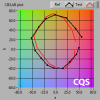Color Quality Scale (CQS): Measuring the color quality of light sources
Posted by Marcel van der Steen in Explanation 11 Comments» The Color Rendering Index (CRI) is a quantitative measure of the ability of a light source to reveal the colors of various objects faithfully in comparison with an ideal or natural light source. The CRI is originally designed to evaluate fluorescent lamps. The CRI was intended to measure the ‘naturalness’ of objects’ colors, not preference. It has been found that the CRI is not reliable when used for LED lamps.
The Color Rendering Index (CRI) is a quantitative measure of the ability of a light source to reveal the colors of various objects faithfully in comparison with an ideal or natural light source. The CRI is originally designed to evaluate fluorescent lamps. The CRI was intended to measure the ‘naturalness’ of objects’ colors, not preference. It has been found that the CRI is not reliable when used for LED lamps.
A successor, the Color Quality Scale (CQS), has implemented a number of improvements making it an alternative to the CRI and a better method for determining the color quality.
The lecture given by Marcel van der Steen in the video below explain why the CRI is not optimal and what improvements have been made by the CQS.
Since February 2015, all lamp measurements by OliNo will have next to the CRI also have the new CQS value.
More info: http://www.olino.org/us/services





11 replies on “Color Quality Scale (CQS): Measuring the color quality of light sources”
It is laudable that you are trying to give better colour information but sadly CQS has not been adopted very widely despite being around for over 5 years and is likely to die.
Various bodies are looking at other metrics to define LEDs more accurately and hopefully we will see the results soon.
I have been reading the details of the CQS and there are a number of advantages over the CRI. There are indeed other metrics and I chose this one for the advantages it has.
That industry does not accept it does not mean it is not good. Adoption also depends on the own interest of industry players. One example I can imagine is the following: the CQS v 7.5 proposed to have a max value less than 100 for CCTs significantly below 3500 K. An practical example is that a reference light source with a CT of 2000K cannot render colors like dark blue well since with light with a CT of 2000K one cannot distinguis these from black. Therefore a color rendering parameter should never be 100 for such a reference light source. This reduction of max value was proposed in v 7.5 but rejected by some industry members. And why? Most likely since those industry members were actually selling light sources with very low CCTs and not wanting to explain to their customers that with such light it is not possible to render all colors well.
This way, it will always be very hard to introduce anything new over something existing that not interferes with private interests of certain (big) companies.
I cannot forecast whether the CQS will be the metric in future, but I see it as an interesting addition to the test results for the reasons mentioned in the video.
Cache flushing after commenting on production should now work. This means that the url’s in the email should now show the latest comments. Can you confirm this? When confirmed you can remove this comment (via admin)
Comment test 2
test 4
test 5
Final comment test (hopefully)
Excellent video, very informative! Proof of how weak CRI values really are. Are your slides available anywhere?
Hi Andrew, here in powerpoint and here in PDF.
Andrew, I did a lot of CQS measurements and found out that there is a very tight correlation between CRI results and CQS results. I admit that about all LED lamps I measure are of the phosphor converted technology. So it seems that for this technology the CQS doe snot differ that much from CRI and that CRI can be usd. I need some time to write an update to this and come with a graph indicating all results.
The Color Quality Scale (CQS) is a user-friendly color quality measurement tool that enables you to evaluate the color quality of your existing light sources. You’ll soon discover that white light from each collection source has a different color quality level, which can impact comfort and health levels, especially if you are sensitive to blue light. Below, I’ve included helpful information on how to use the CQS, along with valuable equipment recommendations that will help you evaluate your current lighting situation.